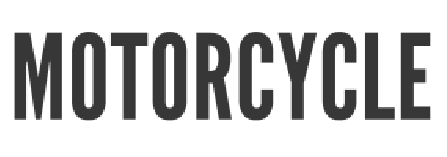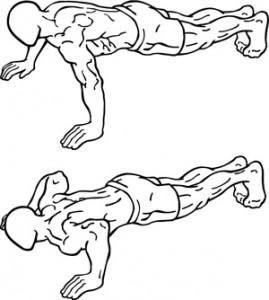Check out this cool time lapse video of a '57 Sportster rebuild, as produced by our pals over at Hagerty Insurance, providers of specialty coverage for Classic and Vintage vehicles.
This video will give you an appreciation of the time, energy and 'love' that goes into doing a rebuild. The ending is pretty funny too!
Wednesday, 31 January 2018
Saturday, 27 January 2018
Wednesday, 24 January 2018
Warm-up, Workout, Cool Down, Stretch!
Before you start a workout it's mandatory you do a light warm-up, maybe 4-5 minutes, to heat up your muscles a little and prepare them for some hard work.
Focus on the muscles you intend to use in your workout and warm-up with some light exercise or a toned down version of whatever you're doing in the workout.
A runner might do a light jog and a weight lifter do some lifts with minimum weights, or you can do some twists and rotations to prepare for a boot camp style workout. Don't forget to consider the temperature, with us folks up here in the cold and snowy north needing to spend a bit more time on warming up properly.
After your workout, you need a cool down and stretch to take advantage of those muscles you heated up during your workout and gain flexibility.
Check out this handy chart of stretches that I found on the internet...

A cool down is a great way to end a workout, especially if you're like me and get heated up and perspire a lot. Really, there's not much point to hitting the shower if you're just going to continue to perspire anyway! haha!
Stretching isn't absolutely critical and I don't always do it myself, being fairly flexible, but it isn't a bad idea and can't hurt if done properly. With flexibility being the objective, doing them after a workout is best because your muscles are warm and you can get the easiest and deepest stretch. Over time your muscles will stay stretched and be more flexible for future workouts.
Tight, tense muscles work against each other and use energy inefficiently, so consistent stretching will improve your flexibility and range of motion and thereby improve your workouts.
Saturday, 20 January 2018
Seriously...Drinking and Driving Is Still An Issue?
Really? In this day and age, there are still people out there who drink and drive?
I just read a report from the Saskatchewan Provincial Government about drinking and driving and the rate is rising, and subsequently the fatalities too. An 8% increase in deaths from the previous year, with 46% of all accidents in the province involving alcohol.
While most fatalities involved the driver of the vehicle, 20% of the total were passengers and 10% were pedestrians, in essence vehicular homicide!
The most at-risk group for casualties associated with impaired driving are 16 -21 year olds, involved in 195 of of the collisions recorded but making up only about 9% of drivers in the province.
The further out of an urban centre one travels, the higher the number of impaired driving related collisions and fatalities.
Approx 37% of fatalities in an urban centre involve alcohol whereas 40% occur on highways, 58% on rural roads and 86% on First nations roads. And, it's no coincidence that most of these impaired driving accidents occur on weekends.
One realizes that urban centres offer many ride alternatives to people who have been drinking, with less options as you get into rural areas. Still, with modern communication networks like the internet to help spread the educational word about the dangers of impaired driving, it is certainly discouraging and alarming to see how people just don't seem to be getting the message!
Wednesday, 17 January 2018
Tips To Help You Stick To Your "Get Fit" Resolution
So, you've committed to getting fitter and losing some weight as part of your New Year's resolution but now there are so many questions about how you're going to make it happen.
Whether you bought a membership at the gym, signed up for some boot camps, or bought some gear for use at home, you may wonder about some of the key elements of establishing a good, solid fitness routine.
9 Of The Most Frequently Asked Questions About Developing A Proper Fitness Regime.
How often should I work out?
I go by the theory that doing something every day is good, but that doesn't mean it has to be something strenuous either. A boot camp style work out one day, a brisk walk with the dog another, or ride your bicycle to work, just get out and move that body.
Of course, only you know your own level of fitness and can judge what is best for you personally. If you're a total newbie or if you have medical issues, you certainly should see a doctor first and get some professional advise on what is and isn't best for you and your body.
Ideally, you want to get your heart rate up to a specific level, and keep it up for a specific amount of time in order to get any benefit. It seems like the consensus is to do an aerobic work out 3 times a week for a total of 2.5 hours, increasing your target heart rate up to no less than 50% as a newbie and working your way in to the 85% range when you become fitter.
Check out this great link for calculating heart rates.
How long should I work out?
Again, this will all depend on your initial level of fitness and will change as your fitness level increases. One could use the Borg Rating System as a gauge...
The Borg Rating of Perceived Exertion (RPE) is a way of measuring physical activity intensity level. Perceived exertion is how hard you feel like your body is working. It is based on the physical sensations a person experiences during physical activity, including increased heart rate, increased respiration or breathing rate, increased sweating, and muscle fatigue. Although this is a subjective measure, a person's exertion rating may provide a fairly good estimate of the actual heart rate during physical activity* (Borg, 1998).
....or by using the target heart rate, as established in the chart in the provided link. Again, you will have to ultimately determine what is a reasonable amount of time based on the advise from your doctor and your own judgement. Perhaps going back to the S.M.A.R.T. program and choosing something that is reasonable and attainable will be the the wisest choice.
When I first started, I did just that and chose a basic workout that seemed manageable. As mentioned, I had to adjust slightly and then made more adjustments as my level of fitness improved.
Based on the suggested 3 times a week for a total of 2.5 hours workout, logic would say that your sessions should last a minimum of 50 minutes per session.
Eventually you'll be like me and get to the point where you want to workout daily. In fact, it is so ingrained in me now that I actually feel agitated if my workout gets missed. By this stage you'll start to break your workouts into sessions, with some High Intensity, some Moderate Intensity and some Low Intensity. Rest days are important, so that low intensity workout might be the walk to the park with the dog, as mentioned previously.
Plan your workout schedule and it stands a better chance of being successful.
What is the best time of day to work out?
My answer to this is simple...when it's convenient and manageable! If you go by the premise that 'the only bad work out is the one you didn't do', then all you need to consider is that you go for a workout at whatever time works with your schedule, as long as you go!
No doubt there are plenty of theories on maximum benefits of working out in the morning or evenings or some other time, but again, what works best for you can only be determined by you.
What should I eat before and after a workout?
Obviously you don't want to be full and feeling bloated while working out, but you also need energy to get you through the session. It may take some experimentation to get the balance between the two right but, if you have time, try eating a small meal of 500-600 calories about 2-3 hours before hand. If not, something smaller like some fruit, 30-60 minutes before hand should work.
Carbs will help give you fuel to burn but you need a mixture of complex and simple ones to get a slow and steady release during the routine.
Try this great pre-workout snack...Whole wheat toast with peanut butter and sliced bananas, with a sprinkle of cinnamon. A combo of complex and simple carbs. Bananas help raise potassium levels that drop when you perspire a lot. The cinnamon helps stabilize blood sugar and improves your brain functions.
What about hydration and electrolytes?
Just like food is important to fuel your body for a workout, your body needs hydration to maintain its' function. You lose fluid through perspiration and your breath and need to be re-hydrating as you go, but having ample fluid in your system before you work out is just as essential.
- take in at least 500-600 ml of water in the one to two hour time period before your workout
- take in another 300-400 ml of water approx 15 minutes prior to starting
- every 15 minutes during the workout, take in 300-400 ml
- those who perspire more need to increase intake
Water lubricates your entire body and is critical to the chemical reactions created by exercise. reactions can be slowed, as well as recovery. Dehydration can cause dizziness, lethargy and cramping.
As for electrolytes found in sports drinks, the average person who works out for approximately an hour can get what they need just by drinking water.
I find that a light workout that helps get the blood flowing and increases circulation definitely helps sore and cramped muscles, as long as that's all that is ailing you and you're not actually injured. A circulatory workout followed by a good stretch. I workout at the world class Repsol Centre in Calgary and after a workout like to alternatively use their steam room or hot tub, and cold tub for a bit of muscle flushing. Of course, this isn't everyone's cup of tea and you do need to be careful when participating in this type of activity
What is best, cardio or strength training?
I say that you need to do both and find some balance between them, as each has benefits. Certainly cardio usually burns fat faster and you are generally exercising one of the more important muscles in your body, that being your heart.
What is the best way to burn off fat?
As mentioned, cardio burns fat a bit faster, but either strength or cardio training, complimented by a proper diet and adequate sleep will do the trick.
Should I monitor my hear rate heart rate?
Going back to the point about getting checked by a physician before commencing a workout routine, they may be advise you to wear a heart rate monitor during your sessions. This may be a temporary requirement and there are other ways to determine if you're hitting an adequate workout level, such as the Borg method we also discussed earlier.
I occasionally wear my heart rate monitor, which is synced to my GPS watch, as a way to see how some of my runs and stair climbs compare to one another. It's also interesting to note how quickly I can get my heart rate down after peaking during a long stair climb or a sprint.
For additional thoughts and suggestions on an attainable workout routine, check out "S.M.A.R.T." and "Fat Is Your Friend (?)".
Saturday, 13 January 2018
Wednesday, 10 January 2018
That New Fitness Routine
As part of my series on New Year's resolutions, particularly the number one and two choices which deal with fitness and weight loss, here are some tips to help a person have some success with achieving those goals.
Of course, just like anything else, the toughest part of getting fit is getting started. Do you join a gym or buy a piece of fitness equipment and work out at home? And figuring out what sort of routine you are going to do is also a bit of a task, especially if you've never been one to hang out at the gym or be involved in any sort of sport or training.
One of the things I like to point out to anyone who is just getting started is that you didn't get out of shape overnight, so getting back into good physical condition is going to take a bit of time. That, and some persistence and consistency.
Which is why the philosophy outlined in my post "S.M.A.R.T." may be a good starting point in it's own right. Specific, Measurable, Attainable, Relevant and Timely are the keys to developing a strategy that will give you successes to help motivate you to achieve even more as you progress.
I think back on my own quest to get fitter and think it's a fine example of just how some small steps taken soon add up to some big leaps and and a fitness level of which I am pretty proud of to this day.
The original plan was to do something simple and do it every day. The first day was just a little warm up and stretch, followed by 5 push-ups and 5 sit-ups, and nothing more. Seems simple enough and it went well, though not as easy as originally thought. I was in decent enough shape and did some physical work with my job, plus had always been active, but evidently I suffered a few delusions about my real fitness level.
Day two came and not only was 5 push-ups a total strain, you could forget about 5 sit-ups!! My abs were so sore that one measly sit-up was all that could be done and to say the least I felt quite deflated! But, as mentioned, the other keys to success was going to be persistence and consistency, so back at it on day three! And, lo and behold, 5 push-ups and 5 sit-ups done, still a bit of a strain but done none the less. Day four, five, six and seven and there went a week of doing the same warm-up and exercises, every morning, before having breakfast and heading off to work.
Better to be achy and sore from working out than from sitting around doing nothing!
As the weeks went by and more push-ups and sit-ups were added, the better I felt. Riding my bike back and forth to work seemed a logical next step, so that helped the cardio immensely.
Day two came and not only was 5 push-ups a total strain, you could forget about 5 sit-ups!! My abs were so sore that one measly sit-up was all that could be done and to say the least I felt quite deflated! But, as mentioned, the other keys to success was going to be persistence and consistency, so back at it on day three! And, lo and behold, 5 push-ups and 5 sit-ups done, still a bit of a strain but done none the less. Day four, five, six and seven and there went a week of doing the same warm-up and exercises, every morning, before having breakfast and heading off to work.
Not only was the accomplishment mentally satisfying but the tightness and muscle aches from the physical exercise actually felt somewhat invigorating.
Better to be achy and sore from working out than from sitting around doing nothing!
As the weeks went by and more push-ups and sit-ups were added, the better I felt. Riding my bike back and forth to work seemed a logical next step, so that helped the cardio immensely.
Though I do so many other things these days, that little morning routine is still something revisited on a regular basis, albeit a much longer process, with a longer warm-up and stretch followed by 100 push-ups and sit-ups.
Doing a bit of something every day and adding to it as your strength and endurance builds has certainly worked for me, so maybe you too?
Saturday, 6 January 2018
Fat Is Your Friend (?)
Fat is your friend, or at least it was for many eons, when day to day life was just that, day to day, and man lived either in feast or famine.
When considering the evolution of man, our bodies compensated for the unpredictability and uncertainty of the hunter/gatherer lifestyle by learning to store kcal energy in the fat of our bodies.
cal (small calorie) = the amount of energy required to raise the temperature of one gram of water by one degree Celsius at a pressure of one atmosphere.
Cal (large calorie) = 1000 cal
Cal = kcal and is referred to as the food calorie, since the cal is too small of a measurement to use in our daily lives when it comes to the typical concept of burning "calories"
Essentially, fat is where we store energy. And certainly, we wouldn't have survived on this earth for 200,000 years if we didn't have that feat of evolution to help us out.
The average man, weighing 75 kg (165 lbs), typically carries 100,000 kcal stored in the form of fat. Consider the fact that if this energy was stored via carbohydrates, which is in the form of glycogen, we'd actually be adding an additional 45 -60 kg to our weight. That might slow a hunter down, to say the least!
Fast forward to the developed countries in the modern world, particularly North America, where things got nice and comfy in the past and 50 or 60 years.
Humans here have no real worries about any kind of 'famine', but they still have the craving for that food that appeals to the fat storing systems that our bodies have developed over millenia. Our bodies have not evolved from this process of storing energy in the form of fat and as a result, obesity is becoming far too common.
But what is fat exactly?
Fats are macronutrients, nutrients we consume in great quantity and from which we get energy. A fat molecule consists of one glycerol molecule and three fatty acids that contain Fdouble bonds based on the saturation.
There are 4 main types of fats in our foods, each with different chemical and physical properties:
- Polyunsaturated fats have two or more Fdouble bonds and are considered 'good', having been shown to lower blood cholesteral. They include the essential fatty acids Omega -3 and Omega -6, which are essential to brain function and cell growth, and do not occur naturally within our bodies.
- Monounsaturated fat have one Fdouble bond and are also considered good fats. They are found in things like avocados, nuts and olive oils.
- Saturated fat has no Fdouble bonds and is generally considered 'bad' fat, though the hypothesis for this theory was largely based on a flawed assumption and has since been proven to be inaccurate.
- Trans fats is the bad boy of all fats. It tastes good and because it is easy and inexpensive to produce, and lasts a long time, it became very popular in the commercial food industry. It is known to lower good cholesterol levels (High Density Lipids) and increase bad ones ( Low Density Lipids)
Conclusion...we should regulate our intake of Saturated Fats by keeping our consumption to approximately 5 -6 % of total calories, and eliminate Trans fats entirely.
6 ways to reduce your consumption of Saturated and trans fats....
- Eat more fruits, vegetables, whole grains, low-fat dairy products, poultry, fish and nuts and limit red meat as well as sugary foods and beverages.
- Use naturally occurring, unhydrogenated vegetable oils such as canola, safflower, sunflower or olive oil.
- Look for processed foods made with unhydrogenated oil rather than partially hydrogenated or hydrogenated vegetable oils or saturated fat.
- Use soft margarine as a substitute for butter, and choose soft margarines (liquid or tub varieties) over harder stick forms. Look for “0 g trans fat” on the Nutrition Facts label and no hydrogenated oils in the ingredients list.
- Limit or eliminate consumption of things like doughnuts, cookies, crackers, muffins, pies and cakes, as many of these foods contain trans fat.
- Be discretionary with commercially fried foods and baked goods made with shortening or partially hydrogenated vegetable oils, which are high in fat, and likely trans fat.
Wednesday, 3 January 2018
So, How About That Resolution?
Happy New Year and best wishes for 2018! Did you make a resolution and are gung-ho to get started down a new path?
If you read my post "S.M.A.R.T.", you've read some great tips on resolutions that will help you plan for something that is achievable, plus learned a few some strategies to make yourself accountable and, ultimately, successful.top 10 resolutions *
- Stay fit and healthy - 37%
- lose weight - 32%
- enjoy life to the fullest -28%
- spend less, save more - 25%
- spend more time with family -19%
- get organized -18%
- will not make resolutions -16%
- learn something new or take up a new hobby -14%
- travel more -14%
- read more -12%
*(based on a 2015 study by info and measurement company Neilsen)
Unfortunately, only about 8% of people consider that they've been successful with their resolutions, leading one to conclude that perhaps ambitions were maybe a bit too lofty and unrealistic, setting a person up for failure before they even got started.
Since #1 and #2 on the list of popular resolutions has to do with fitness, health and weight loss, check out my next post titled "Fat Is Your Friend (?)"
Subscribe to:
Comments (Atom)
























